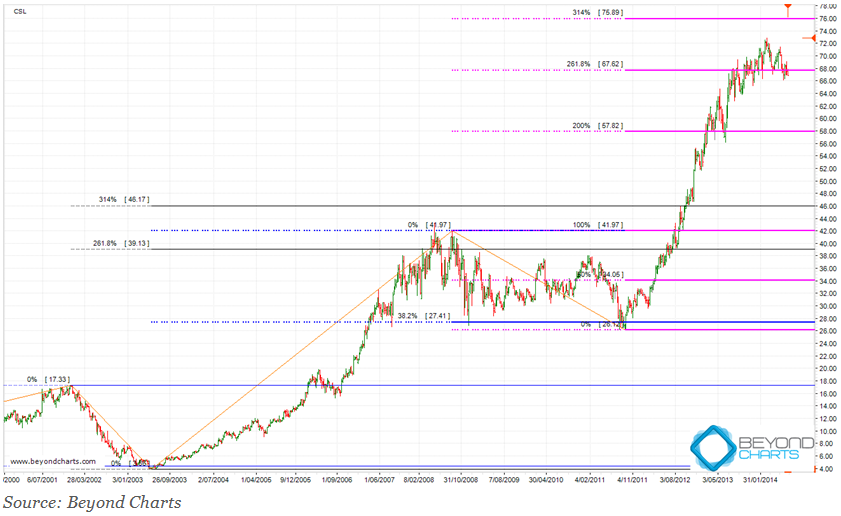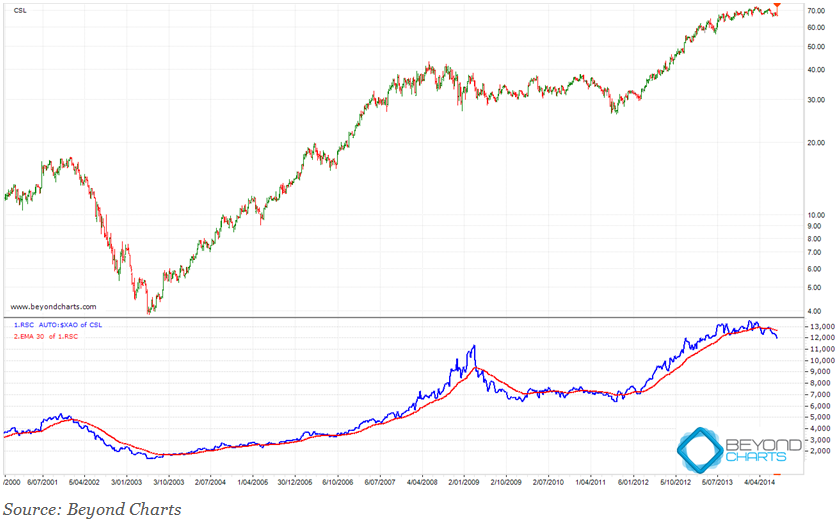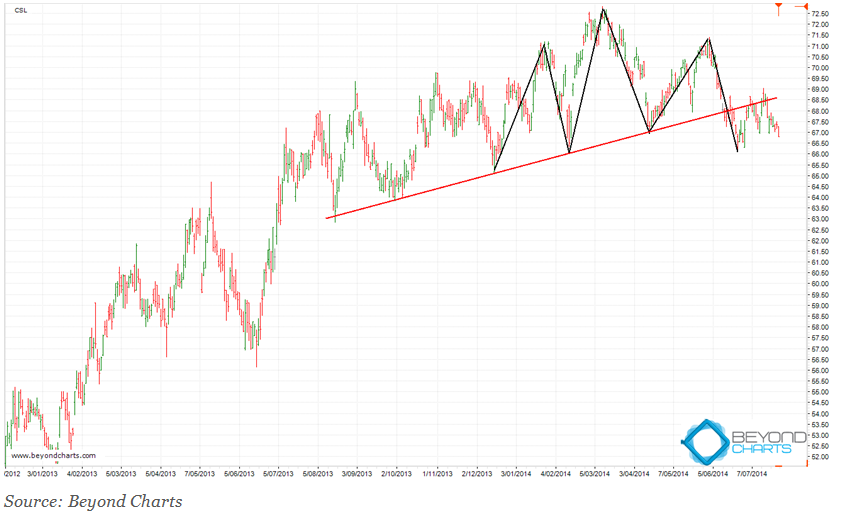CSL Limited (ASX:CSL) is a $31.7 billion market capitalised company and is an ASX20 Index constituent. In fact, it is the 10th largest listed company in Australia by market cap and is the country’s largest listed Health stock and therefore would be a key holding in many managed funds and SMSF’s.
From September 2011 to March 2014 CSL’s stock price performance was stellar, rising 176%. And then there were dividends too.
However there are some strong technical signs that CSL’s share price might be in for some noteworthy underperformance compared to the wider market and there may just be a price retracement of some significance. I can hear my decriers as I write this but I urge you to take heed of the signs highlighted below.
Technical signs of potential weakness
The first chart below, a 14 year weekly chart, shows CSL’s fall in the 2002/2003 bear market, its subsequent rise in the 2003 to 2007 bull market in Australia, the fall and consolidation during the 2008 bear market and, lastly, its brilliant price performance from September 2011.
There are four technical points to make over this period to set up the technical case for potential price weakness over the next few months:
- The 2003 to 2007 price rise halted at between the 261.8% and 314% Fibonacci Projections, shown by the two horizontal black lines in the middle of the chart. These are projections measured relative to CSL’s price decline in the 2002/2003 bear market, shown at bottom left of the chart.
- CSL’s price has recently reached a similar projection between the 261.8% and 314% Fibonacci Projections, shown at top right of the chart. Whilst some stocks can exceed the 314% Fibonacci Projection, it is a rare event and, as such, reaching, or nearly reaching 314%, is an indication of being overbought, some might even say extremely overbought.
- The two retracements that CSL experienced were 78.6% and 38.2% Fibonacci Retracements, respectively. The first retracement is shown bottom left and the second is in the middle of the chart.
- The first retracement in 2002 to 2003 was a fall from $17.33 to $4.31, a fall that was just over three quarters of the rise CSL had achieved from its initial listing in 1994. The second retracement in 2008 to 2011 was a fall of just over a third (38.2%) of the 2003 to 2008 price rise.
The second weekly chart below shows a semi-log graph of CSL’s share price in the top half of the chart. A semi-log graph ‘normalises’ price movement visually so that a price move from, say, $10 to $20, a 100% rise, is scaled as exactly the same as a price move from $20 to $40, also a 100% rise.
In the bottom half of the chart, a graph is shown of the Relative Strength Comparison (RSC) compared to the All Ordinaries Index. The RSC is simply calculated by dividing CSL’s share price by the All Ordinaries and shows relative price performance.
RSC effectively shows how well CSL is performing relative to the All Ordinaries. When the blue line in the bottom graph is rising this means that CSL is outperforming the All Ordinaries and when it is falling this means that CSL is underperforming the All Ordinaries.
At the hard right end edge of the chart below the blue RSC line has turned down and has crossed below the red 30 week moving average line. This is a key technical sign that is clearly showing CSL’s relative price weakness compared to the wider market.
However, the most important technical sign of impending price weakness is the ‘head and shoulders’ pattern, a bearish pattern, which is shown in the daily chart below. This pattern has formed over the first half of 2014.
The ‘head and shoulders’ is depicted by the black lines with two ‘shoulders’, the lower peaks on either side of the ‘head’, a higher peak, in the middle. The ‘head and shoulders’ has a ‘neckline’, the upward slanting red trend line, which forms the signal line upon which to act.
Nice name for a pattern but what does it mean? Technically, the right ‘shoulder’ is a lower peak than the ‘head’ meaning that price has not been able to make a new high, the first sign of weakness. The ‘neckline’ is a support line that is drawn at the two troughs at either side of the ‘head’. The above ‘neckline’ is as good a ‘neckline’ as one might see on a ‘head and shoulders’ pattern.
The ‘neckline’ is key in the pattern as it:
- determines the gradient at which the support trend line is drawn,
- provides an objective signal point on which to act, being the first drop below the ‘neckline’,
- becomes a resistance line at which price might rise to again after first dropping below the ‘neckline’.
CSL’s price action has followed the technical analysis ‘head and shoulders’ bearish pattern to the book having tested the ‘neckline’ twice by attempting to rise above the ‘neckline’ after falling below it, and failing both times.
All these technical signs combine to signal a high probability that CSL’s price might undergo a period of weakness.
From here the odds are that CSL’s price will make a new low below $66.16 and move lower or consolidate in a wide ranging sideways movement for some weeks or even months.
Where a share price retracement ultimately heads is always difficult to determine as there are so many variables that will play a role. Using Fibonacci Retracements alone, in brackets, the projections are $66 (14.6%), $61.80 (23.6%), $55 (38.2%) or even all the way to the midpoint of the last 176% run-up, $$49.50 – $50.
Of course, if support holds at any of these levels and CSL moves higher to make a higher high then this would signal an arresting of the share price fall and might indicate a resumption of CSL’s long standing up trend.
Fundamental signs of potential weakness?
CSL has been a near ‘life member’ since the 1990’s of Share Wealth Systems Gold Medal List of fundamentally sound stocks on the ASX of which there are only 13 stocks that currently qualify for the Gold Medal List. So I am fully aware of CSL’s fundamental pedigree.
However, over recent years CSL’s rate of growth in dividends per share (DPS) and earnings per share (EPS) has been declining with compounded growth over the last three years in DPS and EPS being 9.21% and 12.28%, respectively, compared to the seven year DPS and EPS compound growth of 24.53% and 22.42%, respectively. With the much lower EPS growth one should question whether CSL can continue to sustain a trailing PE Ratio of 22.92. Also, Dividend Yield is now down to just 1.73%.
CSL has long been viewed as a growth stock and under such a banner, if it still fits, can sustain a high PE Ratio. But it also carries the tag of being a defensive stock and if the All Ordinaries gathers some steam from current levels the defensive tag may weigh down CSL relative to other stocks.
Investors need to determine their investing horizon and decide whether to act on such technical signals as put forward in this article and rotate into a different stock holding or to sit through any price weakness without taking any action at this time.
Either way, from a technical analysis charting perspective CSL’s current price situation relative to its past share price movements provides text book material from which investors can learn aplenty. Let’s see how this one plays out….






2 Responses
Wow. This prediction was dead wrong. CSL has rocketed massively to the upside straight after this article went to press. Hope no one has been hurt by this advice. Let’s see how it plays out.
Response to Comment by Simon:
I need to put some perspective around your comment.
Firstly, technical analysis does NOT predict. It uses analysis of past price action to determine the probabilities of future price action.
Secondly, this is not advice, it a view on past price action using a time tested pattern that has a higher probability of playing out as stated than not. There are no guarantees, or probabilities of 1, or 0 for that matter, over a large sample.
Thirdly, successful investors in the financial markets know that there are millions of variables at play in the markets, the great majority of which are out of the control of any single individual or group.
This is why a ‘stop loss’ is required when the pattern doesn’t play out according to its probabilities. The setting of a ‘stop loss’ is a complete acknowledgement of the existence of these variables that can negate the probabilities of any given pattern within seconds.
Not setting a ‘stop loss’ is akin to denial of the existence of these variables and/or the total lack of control that one has over them.
One of those variables is good/bad news that is unknown to the market, as occurred in this instance.
Fourthly, any single trade is just that, a single trade of many whose risk needs to be managed through not only the determination of a ‘stop loss’ but also the allocation of a small portion of investing capital that should be calculated according to the risk taken in any given situation.
Regards
Gary